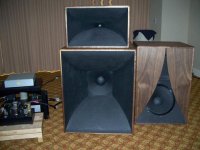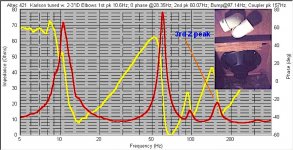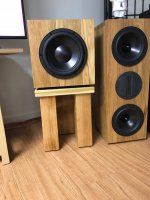So you think a pair of Sub18s would do the trick under any circumstance?id argue NOTHING has changed since then
the entire audiophile industry today is built upon the scam that small bookshelves can sound satisfying
so you have audiophile trying dozen of 6" 2-ways over the years. adding subs, changing pre amps, spending thousands and thousands on amps, source, pre amps, but they use 6" 2 way speakers. They dont understand that what they dislike is their small gutless speakers.
since real big speakers are not affordable, you have a army of audiophile who will never experience real bass.
ORHmm. 40 years ago, when I was still young the answer was easy. Get the biggest JBL you could afford and enjoy excellent bass. No complications with multiple, or even singular subs, no lame excuses with with room acoustics. Clearly, no dsps.
CerwinVega, Jensen 16inch, Wharfedale, any and all of the Japanese speakers with twin 12" woofers, the Radio Shack Mach in any of the variations etc.
We teenagers lusted after them and our parents hated them.
But these days such large boxes have very poor WAF and for a lot of people houses are getting smaller and smaller.
But yes, nothing really beats a pair of low resonance 15inch woofers in stereo, unless it's something bigger.
My beloved drew a solid line on the 18's I was going to buy after seeing the cheap one I brought home and how much room it took up.
JBL 2435hpl to eminence 15lf crossed 24db LR.
Dxb 321 crossover (if I'm remembering right) had some CD eq.
Lastly I did the smiley face on a 10 band eq for the last month it was setup, should have done that all along, oh well.
When I wanted to really crank it, I would slide the active crossover to 1khz.
Dxb 321 crossover (if I'm remembering right) had some CD eq.
Lastly I did the smiley face on a 10 band eq for the last month it was setup, should have done that all along, oh well.
When I wanted to really crank it, I would slide the active crossover to 1khz.
Under most any domestic circumstance. Those things are beasts.So you think a pair of Sub18s would do the trick under any circumstance?
Barry.
is not good bass if it screws up bowed double bass and cello. Cheap powered multiple subs would be one approach. FWIW
I thought the old Karlson box tuned to ~30Hz and loaded with Altec 15" gave a really nice bass presentation with theater organ CDs. Just take a piece of plywood and mount two 3" right angle elbow and attach that over the stock 4.5" (or 3.5") x 9 inch vent. Stock K15 are tuned around 48Hz or so. Exemplar applied boost at tuning.
Perhaps some of the magic was from the relatively low mass Altec.
I'm not sure how much influence the front chamber had. (A stock K
15 and 604-B/E sounds lovely on Gary Karr's bowed bass but does not go 'low")
I thought the old Karlson box tuned to ~30Hz and loaded with Altec 15" gave a really nice bass presentation with theater organ CDs. Just take a piece of plywood and mount two 3" right angle elbow and attach that over the stock 4.5" (or 3.5") x 9 inch vent. Stock K15 are tuned around 48Hz or so. Exemplar applied boost at tuning.
Perhaps some of the magic was from the relatively low mass Altec.
I'm not sure how much influence the front chamber had. (A stock K
15 and 604-B/E sounds lovely on Gary Karr's bowed bass but does not go 'low")
Attachments
Agreed. Testing a pair of sealed 18s in my 1000sq.ft Victorian warehouse loft removed a fair bit of dust from the timbers with one of my favourite test tracks - Paul Simon's The Boy in the Bubble...Under most any domestic circumstance. Those things are beasts.
Barry.
(Home theatre subsonic LF effects would usually need something very different to a purely music system).
Oh, bookshelf speakers were/are a GREAT addition to the Audio menu and a godsaver for a lot of people.
Emphasis on the word bookshelf. (duh!!)
Tons of people simply do not have physical space at home for large speakers placed on the floor, so this is the "next best" thing.
Many, if they have the space, can´t crank large loud cabinets anyway, so ....
The alternative being a table radio or something
No wall shaking Bass? ... so be it.
Deep Bass? (at reasonable SPL?) ... any day of the week, on properly designed systems.
Emphasis on the word bookshelf. (duh!!)
Tons of people simply do not have physical space at home for large speakers placed on the floor, so this is the "next best" thing.
Many, if they have the space, can´t crank large loud cabinets anyway, so ....
The alternative being a table radio or something
No wall shaking Bass? ... so be it.
Deep Bass? (at reasonable SPL?) ... any day of the week, on properly designed systems.
Deep Bass? (at reasonable SPL?) ... any day of the week, on properly designed systems.
Best bass you've ever heard? Probably not... Affordable though...
If you say so........
Would they compare in definition to a pair of Linn 5150s I am currently using? I have a pair of 2269 but have been procrastinating building the Sub18s because the Linns are pretty decent. Very articulate. But they are isobaric 12".Under most any domestic circumstance. Those things are beasts.
Barry.
It's true, of course, I really like the clear and limpid mids, the vocals in evidence and the penetrating brasses, as well as the airy and tinkling high notes, but what I really love and which I can't do without are the BASS, that true, only it makes me come like a maniac. Unfortunately I got tired of searching, I can no longer find speakers with full, powerful, authoritative, defined, deep and engaging, impactful, dynamic bass, with an F3 extension at least below 30 Hz in anechoic. So I'm asking for advice here: which is the best speaker you've ever known with a similar response in the low range, branded or DIY, even large, possibly no more than 150 litres, possibly not costing thousands and thousands of euros and that at least doesn't suck on the rest of the range, especially the vocals? Thank you for even the smallest contribution.
Hi,
We all want that. But as said the room comes into the equation. As members said, the best chance asks to play with subs placement experimentations up to 60/80 hz cause after it is more easier to localise the origin of the sound. Preference is dsp to correct. A mic with a sweep-tone will show the peaks and deeps. There are low and high pressure nodes and when your listening spot is in a low one it doesn't help.
About the monney, yupp I agree but bass wave-length is as long than life is short. So the monney is the only movable factor, it is better to spend where it matters (and buy once cry once)
1- try to treat the room. Helmotz traps in the corners for instance in the ranges where there are peaks.
2- multi subs, not too big because it must be moved for experiments: sealed=plate amps with dsp (servo amped?). One or two subs suffice imho. Get the hifi drivers with Fs lower than 30 hz. A shame Emmince do not distribute easir the Lab 12 driver in Europe. But there are in the other brands like SS, Seas, etc.
3- Bass is 20 hz up to circa 220 hz according the definitions. That means splitting. Often 150 hz to 300 hz, max 500 hz works fine. The slam is around 100 to 200 hz... BUT needs all the harmonics to stay snappy when it is on the reccording. So group delay/phase must get rigth in the low end at minima. FIR filter with DSP can helps if you are not a diva of passive filters design and due to the price of the passive parts today it is certainly less expensive at the end.
A possibility is also to try close open baffle for bass near the listening spot say 1 meter in the middle of the room. 15" to 18" in short H-frame. Due to laws of physics you will mess the first octave or most of it. But 99% of music beginns till 40 hz... Very few materials get lower than that. Sole rare piano pieces, organs too. If you are not fan of Cap Canaveral launchings. Looks more at -F10. If it goes to 25 hz, it is perfectly acceptable. Working on room modes is more important ime by carefull loudspeakers and chair positionings.
It summarises the most part of what has been said already but I tried to include the monney factor and the roadmap operation. There are priorities to make it rigth.
So just my 2 cents there, though it will cost you more.
Last edited:
;-)
My experience:
If the system consists of very good parts, and plays together, it is impossible to separate treble, mid, bass. It remains only clean, clear, "black", "sound", music.
I am not able to support your search)-;
A tip: a separate subwoofer does not a good job: his separate resonating casing in a separate position does the ear detect - as waste sound. The separate amp, or amps, detect the ear: as waste sound. A little chance: do position it in immediate proximity, or behind, the speakers. Use stone or concrete as casing.
And: 30 Hertz is not a quality specification for clean, clear, deep, powerful "bass".
My experience:
If the system consists of very good parts, and plays together, it is impossible to separate treble, mid, bass. It remains only clean, clear, "black", "sound", music.
I am not able to support your search)-;
A tip: a separate subwoofer does not a good job: his separate resonating casing in a separate position does the ear detect - as waste sound. The separate amp, or amps, detect the ear: as waste sound. A little chance: do position it in immediate proximity, or behind, the speakers. Use stone or concrete as casing.
And: 30 Hertz is not a quality specification for clean, clear, deep, powerful "bass".
People say when the power response has a smooth 10 dB diving from 20/40 hz to 15/20 hz, well you are done to the best you can do. Harman curve has a little less 5 dB amplitude iirc.
If the subwoofer does not make the good job, see both positionning and group delay imho...the room too.
If the subwoofer does not make the good job, see both positionning and group delay imho...the room too.
^^ If there is single sub and trying make it play very low frequencies make sure it is big, 18" or something, so it doesn't have too much excursion and harmonic distortion. Its impossible to locate low frequency sound source, but harmonics could reveal it. If a small sub is requested to play 30Hz, EQ boost and all, crossover 80Hz, serious excursion happening and resulting strong third harmonic at 240Hz and past would probably make location obvious. Yes, excursion due to the low frequencies makes the whole bandwidth distort.
All we need to reproduce low frequenies is volume displacement, displacement x conearea. Large displacement means distortion so keep it small and increase cone area instead. Quadruple cone area to get the system 6db louder with same displacement (excursion). Quadruble once more to get octave more low extension with same SPL and displacement.
Just use multiple subs to reduce harmonics and the subs wont localize themselves. Seriously, about all bass issues disappear with multisub setup, at least it is a solution for any bass problem in domestic rooms.
All we need to reproduce low frequenies is volume displacement, displacement x conearea. Large displacement means distortion so keep it small and increase cone area instead. Quadruple cone area to get the system 6db louder with same displacement (excursion). Quadruble once more to get octave more low extension with same SPL and displacement.
Just use multiple subs to reduce harmonics and the subs wont localize themselves. Seriously, about all bass issues disappear with multisub setup, at least it is a solution for any bass problem in domestic rooms.
Last edited:
Try elevating your subs as well. Found this recommendation on Dennis Foley's Acoustic Fields site (www.acousticfields.com), so I tried it.
Elevating the subs helps to reduce the vertical nodes which can be perceptible when moving from standing to sitting, etc.
Recently I built two front-firing 10" sealed subs with the Dayton RSS265HF-4. They are impressive but sounded better after putting them on 16" stands.
With the subs on the floor the bass was strong while I was standing and considerably weaker when sitting.
With the stands it's stong and very even everywhere.
Elevating the subs helps to reduce the vertical nodes which can be perceptible when moving from standing to sitting, etc.
Recently I built two front-firing 10" sealed subs with the Dayton RSS265HF-4. They are impressive but sounded better after putting them on 16" stands.
With the subs on the floor the bass was strong while I was standing and considerably weaker when sitting.
With the stands it's stong and very even everywhere.
Attachments
Last edited:
I never really heard a great bass out of a pair of stereo speakers, especially passive, which I guess makes sense? Since you know, even if your speakers are perfectly linear down to 20Hz in anechoic measurements its all completely irrelevant once placed in any actual room. Without drastic measures anything that comes out of your speakers below room transition frequency is going to be messed up badly anyway.
Gets worse the smaller the room is since transitional frequency moves upwards then messing up the lower midrange too. So unless you built your room from the ground up using absolutely massive treatments to counteract the limitations of acoustically small spaces then you ain't getting linear bass.
Solution to that is as many independent resarch show by now, distributed subwoofer system and DSP integration and correction (which power is greatly underestimated still to this day). As someone who deals a lot with integration I assure you most people can't do that properly and worse some just plug a single sub with no measurements, standard xover, random gain and call it a day, the results are of course catastrophic to bass quality. Even 3 cheap smaller subs will offer greatly increased bass fidelity when properly set up compared to just stereo speakers which are by themselves greatly limited by physics of small acoustical spaces like any domestic space.
Ultimately answering the question in OP, the absolute best bass I have ever heard was a Double Bass Aray in certain private home theater in germany (total of 8x 18 inch subwoofers), which removes to room influence altogether leaving bass linearity approaching the ideal theory.
Gets worse the smaller the room is since transitional frequency moves upwards then messing up the lower midrange too. So unless you built your room from the ground up using absolutely massive treatments to counteract the limitations of acoustically small spaces then you ain't getting linear bass.
Solution to that is as many independent resarch show by now, distributed subwoofer system and DSP integration and correction (which power is greatly underestimated still to this day). As someone who deals a lot with integration I assure you most people can't do that properly and worse some just plug a single sub with no measurements, standard xover, random gain and call it a day, the results are of course catastrophic to bass quality. Even 3 cheap smaller subs will offer greatly increased bass fidelity when properly set up compared to just stereo speakers which are by themselves greatly limited by physics of small acoustical spaces like any domestic space.
Ultimately answering the question in OP, the absolute best bass I have ever heard was a Double Bass Aray in certain private home theater in germany (total of 8x 18 inch subwoofers), which removes to room influence altogether leaving bass linearity approaching the ideal theory.
- Home
- Loudspeakers
- Multi-Way
- The best bass ever heard (and possibly affordable)


